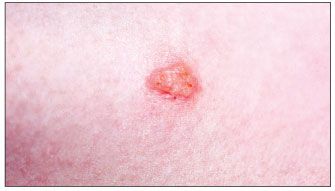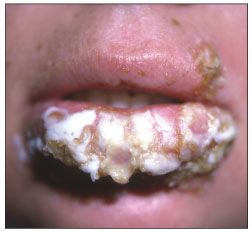- Clinical Technology
- Adult Immunization
- Hepatology
- Pediatric Immunization
- Screening
- Psychiatry
- Allergy
- Women's Health
- Cardiology
- Pediatrics
- Dermatology
- Endocrinology
- Pain Management
- Gastroenterology
- Infectious Disease
- Obesity Medicine
- Rheumatology
- Nephrology
- Neurology
- Pulmonology
Herpes Simplex: Initial and Recurrent Infections
Herpes simplex virus (HSV) infections are caused by 2 types of HSV: type 1 (HSV-1) and type 2 (HSV-2). Most cases of HSV infection are caused by HSV-2. Most persons with HSV-1 or HSV-2 infection have no or only minimal signs or symptoms. When signs do occur, they usually appear as one or more small blisters or sores on or around the mouth, lips, nose, face, genitals, and buttocks. HSV infections are very contagious and are spread by direct contact with the skin lesions.
Herpes simplex virus (HSV) infections are caused by 2 types of HSV: type 1 (HSV-1) and type 2 (HSV-2). Most cases of HSV infection are caused by HSV-2. Most persons with HSV-1 or HSV-2 infection have no or only minimal signs or symptoms. When signs do occur, they usually appear as one or more small blisters or sores on or around the mouth, lips, nose, face, genitals, and buttocks. HSV infections are very contagious and are spread by direct contact with the skin lesions.
Herpes labialis is a common disease caused by infection of the mouth area with HSV-1. Most persons in the United States are infected with HSV-1 by age 20 years.
The blisters or sores associated with HSV infection may take 2 to 4 weeks to heal completely the first time they occur. Typically, another outbreak can appear weeks or months later at the same site, but it almost always is less severe and of shorter duration than the initial outbreak. Although HSV can remain in the body indefinitely, the number of recurrent HSV infections tends to decrease over a period of years.
Herpes simplex virus type 1
Although lesions caused by HSV-1 infection typically appear on the mouth, lips, nose, and face, they can develop anywhere on the skin. For example, a 25-year-old woman sought evaluation of an itchy lesion on her neck, shown in Figure 1. Almost a year earlier, a similar lesion had occurred at the identical site after she had worked in the yard. Her physician had suspected rhus dermatitis at the time and had prescribed a topical corticosteroid; the lesion had resolved.

Figure 1 –An itchy, vesicular lesion was caused by an unusual case of herpes simplex virus type 1 infection. (Photo courtesy of David L. Kaplan, MD. Overview adapted from Dermclinic in Consultant. 2008;48:673-680.)
A diagnosis of HSV infection was made on the basis of the vesicular lesion depicted here; the lesion recurred at the same site, and the physician initiated antiviral therapy. A culture was positive for HSV-1.
Herpes simplex virus type 2
Persons with HSV-2 infection are often unaware of their illness for several reasons. They may have become infected with HSV-2 during sexual contact with a person with a genital HSV-2 infection who does not have visible sores and may not know that he or she is infected. In addition, they may never have signs and symptoms or may have very mild signs that either they do not notice or they mistake for such skin conditions as insect bites. However, if signs and symptoms occur during the initial outbreak, they may be pronounced and may include sores, fever, and swollen glands.
Figure 2 shows a pruritic eruption that was confined for several days to the buttocks of a 73-year-old woman. She was otherwise healthy. She was widowed and had had no sexual contacts for many years.
Antiviral therapy was started because the woman’s physician suspected HSV infection. A culture confirmed the diagnosis of HSV-2 infection. Additional information from the history revealed that the woman had been exposed to HSV-2 infection many years ago.
Figure 2 –This pruritic eruption on the buttocks of an elderly woman is an example of herpes simplex type 2 infection. (Photo courtesy of David L. Kaplan, MD. Overview adapted from Dermclinic in Consultant. 2008;48:673-680.)
Figure 3 depicts a tender eruption that was present on a 28-year-old woman’s posterior right thigh for 3 days. She had no history of a similar eruption. She was otherwise healthy but had had seasonal allergies as a child. Recently, she had started to use new brands of both soap and shaving cream.
Figure 3 –A tender blister on the posterior thigh of a 28-year-old woman is characteristic of herpes simplex virus type 2 infection. (Photo courtesy of David L. Kaplan, MD. Overview adapted from Dermclinic in Consultant. 2008;48:833-840.)
A culture identified HSV-2. Treatment with oral antivirals was started. The patient received counseling on being evaluated for other sexually transmitted infections as well as on the ramifications of genital HSV-2 infections.
Herpes labialis
Although initial herpes labialis may not cause symptoms or mouth ulcers, the virus remains in the nerve tissue of the face and may reactivate, producing recurrent cold sores, usually at the same site. Symptoms of primary herpes labialis may include a prodrome of fever, followed by a sore throat and mouth and submandibular or cervical lymphadenopathy. In children, gingivostomatitis and odynophagia are also observed.
Painful vesicles develop on the lips, gingiva, palate, or tongue and are often associated with erythema and edema. The lesions ulcerate and heal within 2 to 3 weeks.
A classic manifestation of herpes labialis is shown in Figure 4. After returning from a skiing trip to Colorado, a 24-year-old woman sought medical attention for an eruption of sudden onset on her lip. She also had a sore throat and low-grade fever. She was otherwise healthy, and her only medication was an oral contraceptive.

Figure 4 –These painful vesicles that erupted suddenly and were accompanied by low-grade fever and a sore throat are characteristic of herpes labialis. (Photo courtesy of David L. Kaplan, MD. Overview adapted from Dermclinic in Consultant. 2008;48:1022-1028.)
